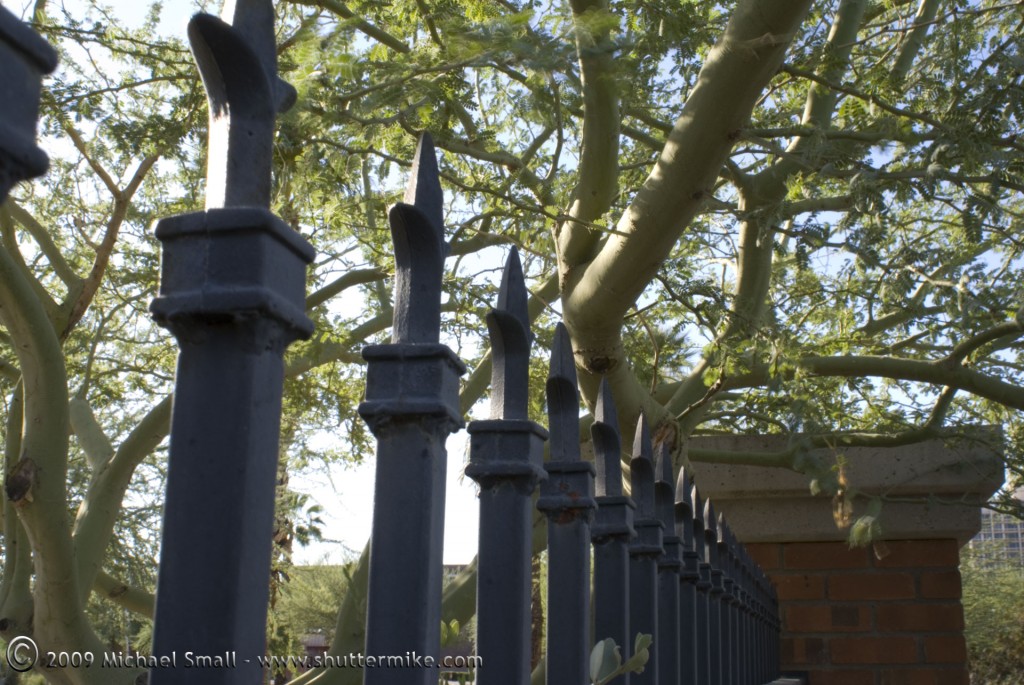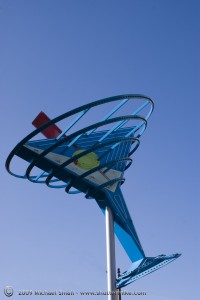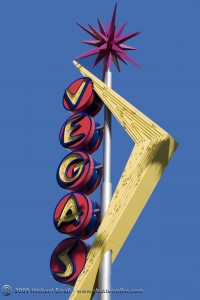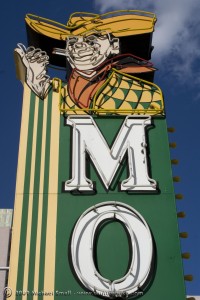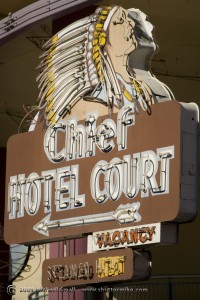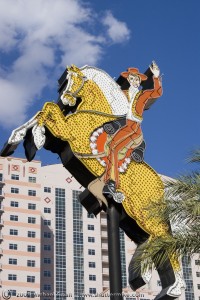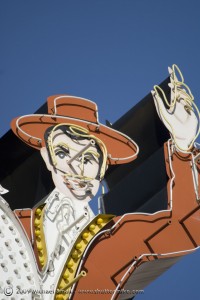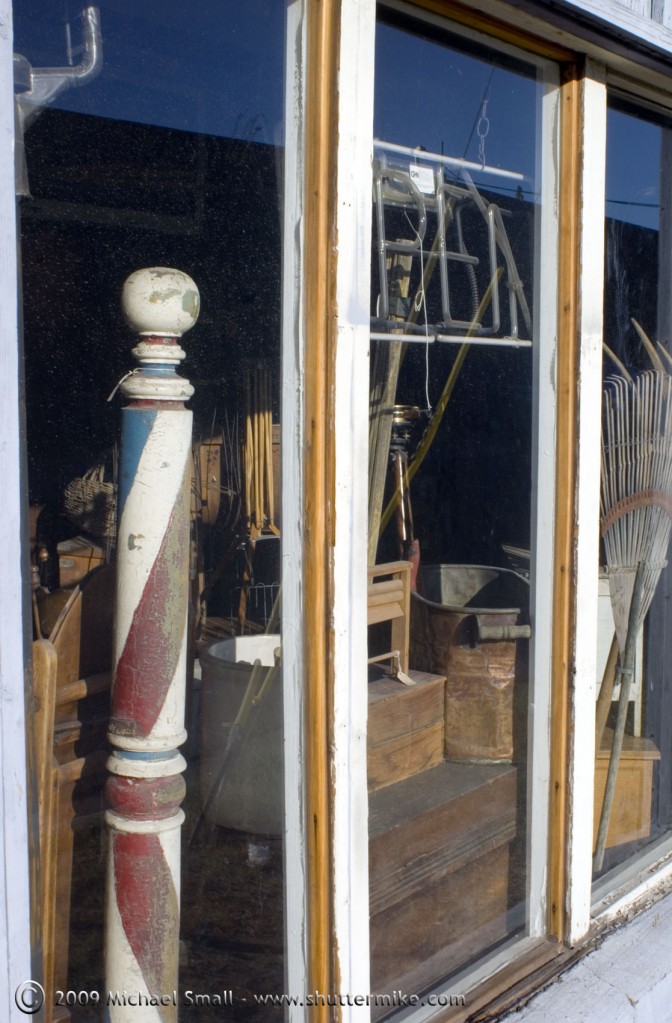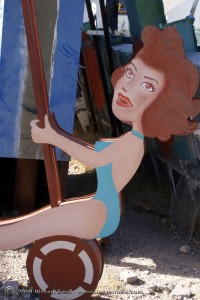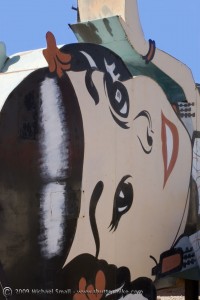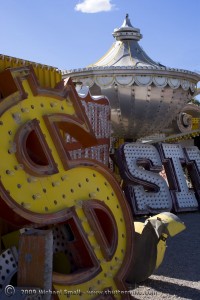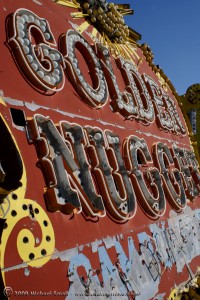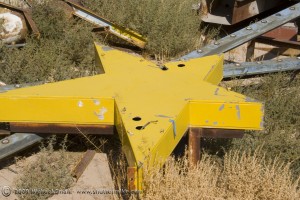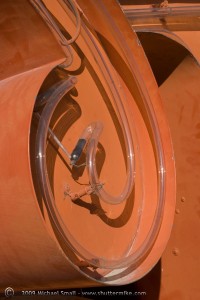More practice with depth of field. Using a smaller aperture brings more of this image into focus. Each post of the fence surrounding the Steel Indian School Park in central Phoenix as well as the brick column and Palo Verde tree in the background are in focus. Using a larger aperture would have narrowed the depth of field to just the part of the scene I was focused on.
I posted the other day about the Neon Museum in Las Vegas and the great photography opportunities in their boneyard. For the signs that make it out of the boneyard the museum restores them to their original glory and installs them along downtown Las Vegas’ Fremont St. There are nine restored signs in place. Here are a few of them.
I have been practicing “mastering” depth of field lately and posted about it the other day. I spent Saturday morning at the Chinese Cultural Center in Phoenix at 44th St. and the 202 freeway. It is a combination retail and office development and small Chinese themed park. The park contains temple reproductions, koi ponds, garden paths, and statuary which are all worth photographing. But this photograph of simple, everyday shopping carts outside of the Ranch Market was a great chance to try out some more depth of field shots. The large aperture (f/5.6 ) allowed me to focus on the middle cart handle and get it sharp while blurring the first cart and those in the background.
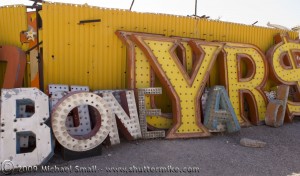
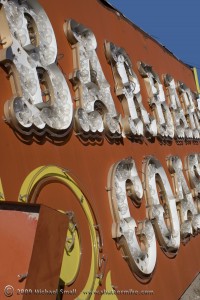 There is a museum in Las Vegas that ironically is all about the glitter that is Vegas yet is itself rather subdued. No flashing neon arrows pointing to its displays, no prominent location on The Strip, nor will you even be able to find out its location too easily. The Neon Museum in Las Vegas is a bit clandestine. You will only be told its exact location after you have a confirmed reservation. There are no self guided tours of its exhibits and no one gets in without a reservation, usually made months in advance.
There is a museum in Las Vegas that ironically is all about the glitter that is Vegas yet is itself rather subdued. No flashing neon arrows pointing to its displays, no prominent location on The Strip, nor will you even be able to find out its location too easily. The Neon Museum in Las Vegas is a bit clandestine. You will only be told its exact location after you have a confirmed reservation. There are no self guided tours of its exhibits and no one gets in without a reservation, usually made months in advance.
All the secrecy makes the experience seem a bit more special. Like you are a part of a secret club. The Las Vegas Neon Museum houses, preserves, and eventually restores what has made Vegas famous. Its neon signs. Restored signs are displayed on and near Fremont St. while those that are waiting to shine again are stored in the museum’s boneyard. The tours offered by the museum are of their 3 acre boneyard and will set you back $15. But if you love Vegas, vintage signs, history, or just a unique experience this tour is well worth it.
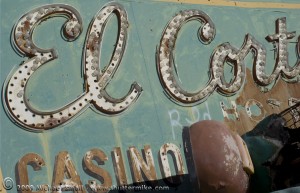 The signs are in various stages of repair or disrepair as the case may be. You are forewarned to wear close toed shoes as the boneyard is littered with broken light bulbs and rusted metal.
The signs are in various stages of repair or disrepair as the case may be. You are forewarned to wear close toed shoes as the boneyard is littered with broken light bulbs and rusted metal.
The museum is in the process of restoring the mid-century modern lobby of the La Concha Motel as their visitors center which was designed by Paul Revere Williams. A prominent icon such as the La Concha as a visitor center is sure to negate any secrecy that currently surrounds the museum.
As you would imagine, hotel and casino signs dominate the collection of the Neon Museum. But not to be outdone in glitz and glamor everyday businesses went all out with their signs in Vegas as well. The one on the right above is from a Chinese restaurant.
If Vegas did not coin the phrase, “keeping up with the Joneses” it does its best to keep it alive. The next best thing is always in the works. That means old hotels are continuously being imploded to clear the way for bigger, better and flashier. And those casinos that do survive need updated images every few years. So old signs come down and many find their way to the neon boneyard. The lamp above is from the Aladdin before it met some well placed TNT and the one on the right is the Golden Nugget.
The boneyard was a gold mine of photo opportunities for me. It has everything; color, lines and shapes, great compositions, and a story to be told. The tour does not allow for much exploring on your own, which I would have loved to do. But if you pay attention there are shots around every corner, from the obvious full-size hotel sign to more subtle ones. The “fallen star” above is very Vegas to me and cold be telling a classic Vegas story. What was once a bright star served its purpose, faded and is now laying in a boneyard waiting for another chance. A sign or a Vegas dream?
17 Oct 2009
Depth of Field Explained
Photo Techniques, Photography 101, Photography How To Tips No CommentsI must admit depth of field has been a fundamental photography concept that has been difficult for me to master. Although I am far from mastering it I have managed to take the first step, which is understanding it. So I figured I would give the “Cliff Notes” version of depth of field for anyone else who is struggling to understand it.
What is Depth of Field?
Depth of field refers to the portion of an image that is in focus or sharp. It is a great tool to tell the viewer what part of the image is most important by only having that part in sharp focus. It is generally divided into two categories; narrow or shallow depth of field and great depth of field. Narrow or shallow means that a very limited (or narrow) part of the image is in sharp focus and the rest of the image, in front of and behind the main subject of the image, is blurred. Great depth of field is just the opposite. A greater portion of the image including the space in front of and behind the main subject is in focus.
How do you control depth of field?
There are three factors that affect the depth of field of your photograph.
- Aperture Size
- Focal Length
- Lens-to-Subject Distance
Aperture Size
Put simply, the smaller the aperture (the larger the f-stop #) the greater the depth of field and the larger the aperture (the smaller the f-stop #) the shallower the depth of field. So if you have three objects lined up at varying distances from each other and you want to capture the front object in sharp focus while blurring the others open your aperture way up to whatever your smallest f-stop is for the focal length you are using (f/5 for example) and focus on the front object (top photo below). If you want all three objects in relative focus close your aperture down to your largest available f-stop (f/22 for example) (bottom photo below).
large aperture/small f-stop = shallow depth of field
small aperture/large f-stop = great depth of field
Focal Length
Shorter focal lengths lenses result in a greater depth of field while longer focal length lenses result in a more shallow depth of field. For example if you are using a 35 mm to 70 mm zoom lens and focus on your subject at 35 mm with an aperture of f/8 you you will get your subject as well as more of the foreground and background in focus (top photo below). Then when you change the focal length to 70 mm at the same f/8 aperture the resulting depth of field will be narrow, meaning a blurred background and foreground and sharper subject (bottom photo below).
short focal length (~50 mm) = great depth of field
long focal length (~200 mm) = shallow depth of field
Lens-to-Subject Distance
The further you are from your subject the greater your depth of field will be. Conversely, the closer you are to your subject the more narrow your depth of field will be. For example, taking a photograph of a group of people in front of a scenic background from 20 yards away will result in both the people and the background being in focus. While moving closer to the people, say 5 yards, will result in the people being in more sharp focus while the background begins to blur.
further away from subject = great depth of field
closer to subject = shallow depth of field
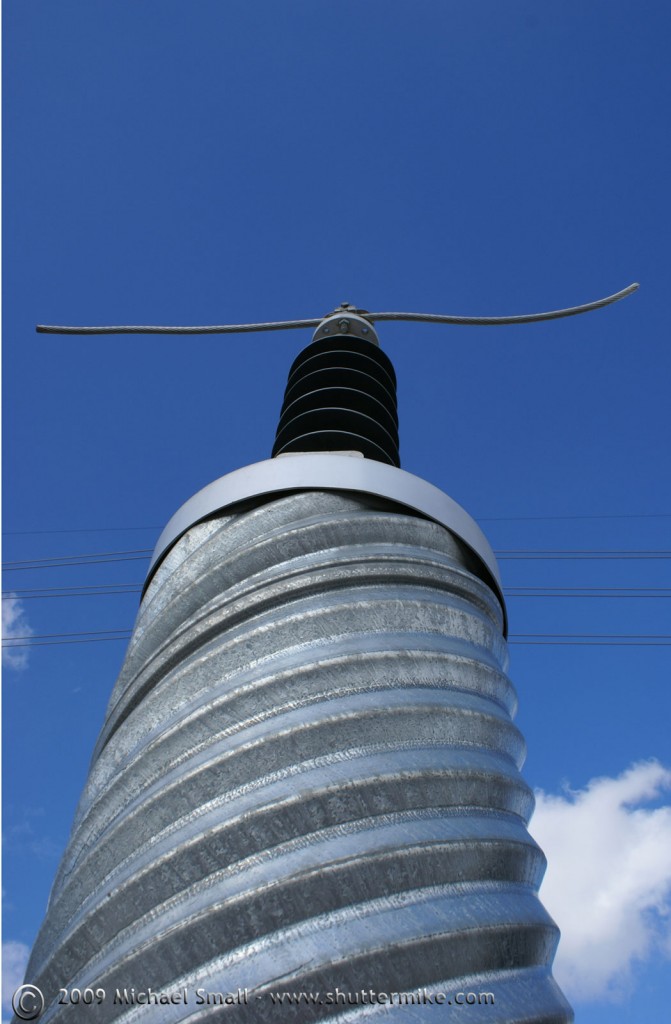 Entrance to Arizona Falls
f/10 – ISO 100 – Focal Length 20 mm
Entrance to Arizona Falls
f/10 – ISO 100 – Focal Length 20 mm
I have posted about Arizona Falls in Phoenix before and it falls into one of my favorite places in Phoenix to photograph. The lines, textures and industrial look and feel of this small power plant on the Phoenix canals is great for photography. I have returned several times and each time manage to see it in a different way.
16 Oct 2009
More Phoenix Area Desert Parks for Nature & Landscape Photography
Arizona Photography, Phoenix Area Photography No CommentsAs a follow up to my post yesterday about Phoenix area desert parks for photography I should point out that the 8 desert parks I mention just scratch the surface. I have lived here a long time, but have not even gotten close to getting to all the parks we have in the greater Phoenix area. Dawna from the Maricopa Parks Department pointed out that their newest park, Spur Cross Ranch Conservation Area, is another great spot to photograph the Arizona desert. I have not been to this park yet, but the description on the County’s site is very enticing. It seems to have all the great photographic elements: archaeology sites, riparian areas, wildflowers in spring, tons of vegetation, and more. I have added this park to my “spots to photograph” list and will post once I make my way up there.
Check out the Maricopa County Parks site and let me know if there are any other parks you recommend.
15 Oct 2009
Top Phoenix Area Desert Parks for Nature & Landscape Photography
Arizona Photography, Phoenix Area Photography 2 CommentsI am always looking for spots to photograph in Phoenix and the surrounding metro area. Since my photographic style is rather diverse, everything from architecture to nature to signs, I can generally find something worth shooting. So I figured I would share some of my favorite nature and landscape photography spots in Phoenix.
View Top Desert Parks in the Phoenix Area for Photographing in a larger map
 The McDowell Sonoran Preserve is in North Scottsdale. Take the 101 (Pima) freeway north, exit on Shea Blvd and head east to 124th St. This will get you to the Lost Dog Wash Access Area.
The McDowell Sonoran Preserve is in North Scottsdale. Take the 101 (Pima) freeway north, exit on Shea Blvd and head east to 124th St. This will get you to the Lost Dog Wash Access Area.
The Preserve offers an extensive network of hiking trails (mountain biking and horseback riding too). You basically can’t go wrong with any of them as they all offer awesome photograph opportunities. This park is very well laid out and is the Sonoran Desert at its best. Wide angle desert landscape and close up details of desert vegetation are just some of the photographs you can capture.
 Papago Park is very centrally located where Phoenix, Tempe and Scottsdale meet. Take the 202 freeway to the 52nd St/Van Buren exit and head east on Van Buren. Turn north on Galvin Parkway and the park will be on your right.
Papago Park is very centrally located where Phoenix, Tempe and Scottsdale meet. Take the 202 freeway to the 52nd St/Van Buren exit and head east on Van Buren. Turn north on Galvin Parkway and the park will be on your right.
Papago Park is made up of the Phoenix Desert Botanical Garden and the Phoenix Zoo in addition to some great red rock formations. The red rocks are beautiful at sunset but just as great to photograph in early morning. Mountain bikers and rock climbers frequent Papago as well. So if you are up for some action sports photography with a desert backdrop this may be the spot for you.
 Usery Mountain Regional Park is east of Phoenix in Mesa. Take the 202 or US 60 east to Ellsworth then head north to Usery Pass Rd. The park will be on your right and there is small entrance fee required.
Usery Mountain Regional Park is east of Phoenix in Mesa. Take the 202 or US 60 east to Ellsworth then head north to Usery Pass Rd. The park will be on your right and there is small entrance fee required.
This vast desert park is ripe with photograph opportunities. Hiking and equestrian trails are plentiful and with so much space it is a great park for some solitary photography. I especially like the landscapes. There are spans of desert vegetation, rock formations, and on a good day deep blue skies.
San Tan Mountain Regional Park
Head way out east and way south for San Tan Mountain Regional Park. If you made it to Tucson you went too far south. Easiest way to get to the San Tans is to take the southern 202 freeway (San Tan Freeway) to the Warner exit. Take Warner east to Ellsworth, Ellsworth south to the Hunt Highway, and the Hunt to Thompson Rd south. Follow the signs from there.
With over 10,000 acres of land in the San Tan Mountain Regional Park most everyone can find something to do here. You are unlikely to come out of this park without having found something to photograph. Be it wildlife, cacti, or more of those great Arizona desert landscapes.
South Mountain Park and Preserve
 The main entrance to South Mountain Park can be found off of Central Ave. Take the baseline exit off of I-10 and head west to Central. Turn left and Central will take you right to the entrance of the park.
The main entrance to South Mountain Park can be found off of Central Ave. Take the baseline exit off of I-10 and head west to Central. Turn left and Central will take you right to the entrance of the park.
If hiking on foot is not your thing, the Central Ave. side of South Mountain Park has easy vehicle access to some very good spots for nature and landscape photography. But no worries, the hiking trails are awesome as well. And be sure to check out the entrance from Ahwatukee as well. This is a popular park, but has enough space to let you spread out and focus on capturing your best shots. There are also several stone structure near the entrance that are worth exploring with your camera.
Rio Salado Habitat Restoration Area
 This is an urban oasis just south of downtown Phoenix. You can either take the 7th Ave. exit off I-10 and head south through downtown or avoid downtown and exit at Baseline and head west as you would for South Mountain Park, but turn North on Central Ave this time to the park.
This is an urban oasis just south of downtown Phoenix. You can either take the 7th Ave. exit off I-10 and head south through downtown or avoid downtown and exit at Baseline and head west as you would for South Mountain Park, but turn North on Central Ave this time to the park.
You will definitely know you are still in the city when at the Rio Salado Habitat, yet you are removed from it all too. The park is on land that used to be a dump in the river bed. The juxtaposition of nature and the urban environment are a great photographic subject in this park. Such as in this photo of concrete columns left standing from some long since gone structure in the morning sun with a Palo Verde growing up around them. The water features have also resulted in the park being a habitat for water fowl. So if you are into photographing birds, give this park a try.
 Camelback is the mountain right in the middle of Phoenix (or pretty close to the middle). You can basically find it by sight by just driving in the direction of what looks like a giant camel lying down in the desert. But if you need some more specifics, exit from the 202 freeway (Red Mountain) at 44th St. and head north. Camelback will eventually be on your right as you follow 44th St . around the west side of the mountain. Keep going around to McDonald and the entrance to the Echo Canyon side will be on your right.
Camelback is the mountain right in the middle of Phoenix (or pretty close to the middle). You can basically find it by sight by just driving in the direction of what looks like a giant camel lying down in the desert. But if you need some more specifics, exit from the 202 freeway (Red Mountain) at 44th St. and head north. Camelback will eventually be on your right as you follow 44th St . around the west side of the mountain. Keep going around to McDonald and the entrance to the Echo Canyon side will be on your right.
Camelback Mountain is a very well known hiking spot in Phoenix. It offers some challenging hiking trails (hand rails and stirs built in) as well as spectacular views of Phoenix and Paradise Valley. The red rock formations are similar to those in nearby Papago Park and they play well with the light in both the early morning and at sunset.
Since we have a South Mountain we have to have a North Mountain. And, as you would imagine, it is on the northern end of Phoenix. Take the 51 freeway north to Thunderbird Rd. Then head west to 7th St. Turn south on 7th to the park entrance.
North Mountain Park is a vast expanse of land with diverse hiking trails and many potential photograph subjects. The good thing about this park is that it is within easy access if you are staying on the north or west sides of town. It is another one of those in the middle of it all parks yet you would never know it given the tranquil desert setting.
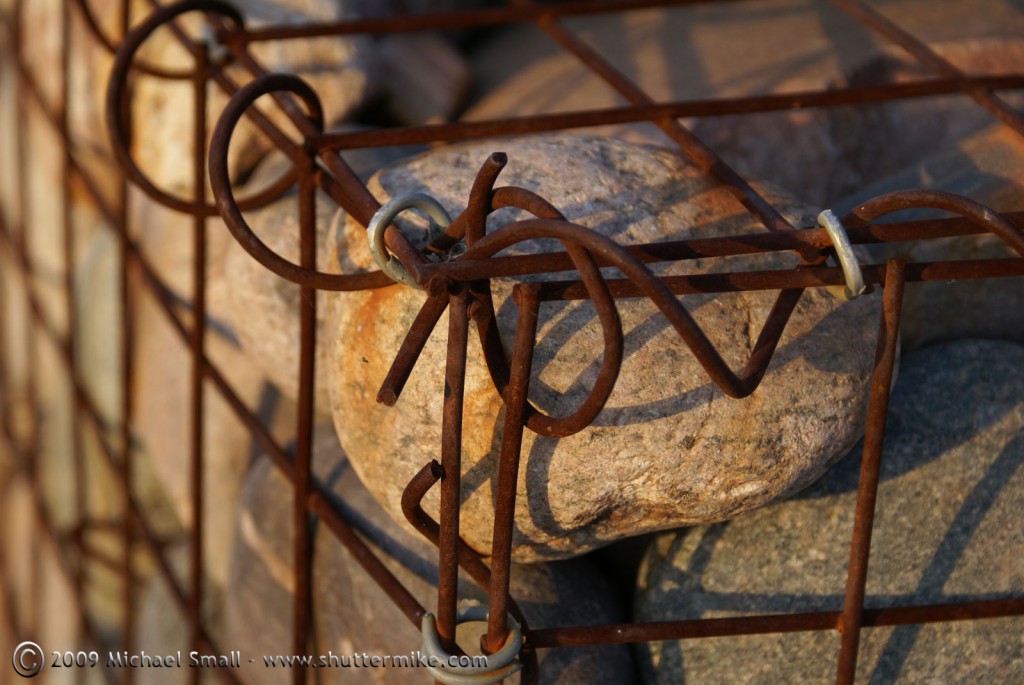 The Rio Salado Habitat Restoration Area – Caged Rocks
f/5.6 – ISO 100 – Focal Length 70 mm
The Rio Salado Habitat Restoration Area – Caged Rocks
f/5.6 – ISO 100 – Focal Length 70 mm
The Rio Salado Habitat Restoration Area is located south of downtown Phoenix along the Salt River in an area that used to be a dump (hence the restoration part of the name). The habitat area and park contains wildlife, desert vegetation, water and sculptural features such as this “rock cage.”
